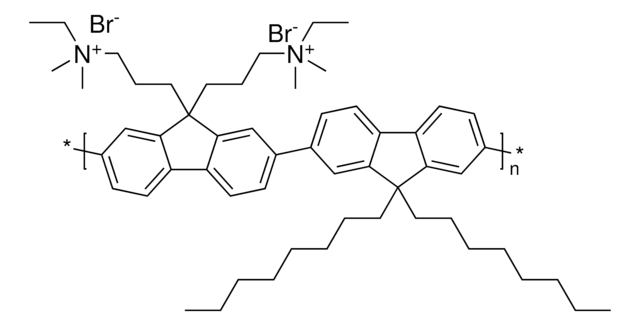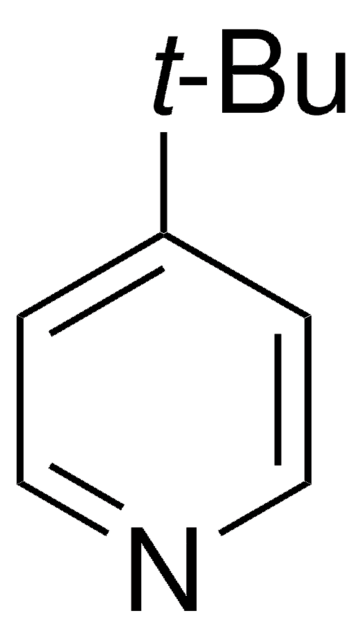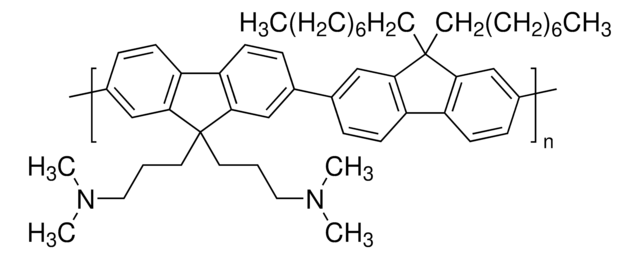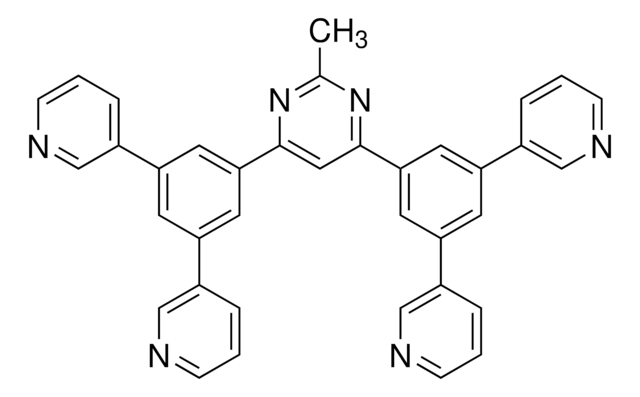907065
Poly-TPD
Mw ≥20,000 g/mol
Sinonimo/i:
4-Butyl-N,N-diphenylaniline homopolymer, Poly(4-butyl-N,N-diphenylaniline), Poly(4-butyltriphenylamine), Poly[N,N′-bis(4-butylphenyl) -N,N′-bis(phenyl)-benzidine]
About This Item
Prodotti consigliati
Descrizione
Solution processable
Stato
powder
PM
Mw ≥20,000 g/mol
Caratteristiche più verdi
Design for Energy Efficiency
Learn more about the Principles of Green Chemistry.
sustainability
Greener Alternative Product
Punto di fusione
>300 °C
Energia dell’orbitale
HOMO -5.2 eV
LUMO -2.4 eV
Categoria alternativa più verde
Temperatura di conservazione
15-25°C
Descrizione generale
Applicazioni
Indoor photovoltaics is one of the best sustainable and reliable energy source for low power consumption electronics such as the rapidly growing Internet of Things.
In another recent study, Perovskite photovoltaic (PPV) cells with a mesoporous PPV (mPPV) structure using typical Spiro-OMeTAD as the hole transport layer (HTL) shows the highest maximum power density (Pmax) of 19.9 μW/cm2 under 200 lux and 115.6 μWcm-2 under 1000 lux (without masking), which is among the best of the indoor PV. When PEDOT:PSS is replaced by Poly-TPD as HTL in the inverted PPV (iPPV) cell, the Pmax under indoor light improves significantly and is comparable to that of the best mesoporous mPPV cell.
Device performance:
iPPV-Poly-TPD
1. under one sun [Pin=100 mW/cm2]
Jsc=21.8 mA/cm2
Voc=1.07 V
FF=73.7%
PCE=17.2%
2. under 1000 lux [200 lux]
Jsc=172.3 mA/cm2
Voc=0.851 V
FF=75.9%
Pmax=111.3 mW/cm
- Organic Light Emitting Diode (OLED): Hole transport layer / Electron blocking layer (HTL/EBL) Materials
- Solution-Processed OLED : Polymer hole transport layer
- Dye-Sensitized Solar Cell (DSSC):Hole transport materials
- Perovskite Solar Cells:Hole transport material
- Flexible Printed Electronics:Hole transport layer / Hole injection layer(HTL/HIL) Polymers
Codice della classe di stoccaggio
11 - Combustible Solids
Classe di pericolosità dell'acqua (WGK)
WGK 3
Punto d’infiammabilità (°F)
Not applicable
Punto d’infiammabilità (°C)
Not applicable
Scegli una delle versioni più recenti:
Possiedi già questo prodotto?
I documenti relativi ai prodotti acquistati recentemente sono disponibili nell’Archivio dei documenti.
I clienti hanno visto anche
Articoli
Professor Chen (Nankai University, China) and his team explain the strategies behind their recent record-breaking organic solar cells, reaching a power conversion efficiency of 17.3%.
Il team dei nostri ricercatori vanta grande esperienza in tutte le aree della ricerca quali Life Science, scienza dei materiali, sintesi chimica, cromatografia, discipline analitiche, ecc..
Contatta l'Assistenza Tecnica.










